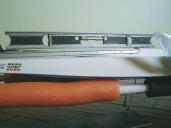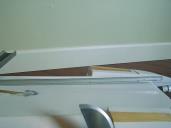





lift the back of the boat.
The latest 8255 design is Brian
Buaas’ 1/10 scale hull. The boat is large
for the power available under the 1/10
scale rules, so it is a high lift design.
The break is well aft and an air trap
extends all the way to the break. This
packs a lot of air under the front of the
boat for an air cushion that extends well
back. This gives a more balanced lift
than the previous designs that tend to lift
the bow more. Air traps are an excellent
way to influence the center of lift and the
Mutt design also uses an air trap in the
afterplane.
Now the afterplane is running nearly
parallel to the strut to sponson line. The
angle between the front of the tunnel and
the afterplane area is smaller than the
previous hulls. Still, the deep sponsons
combined with an aft break and long air
traps give a lot of lift. The center of this
lift is now closer to the balance point so
the boat doesn’t blow off easily.
A problem with wings in ground
effect is center of lift movement with
height above the water. A wing in
ground effect has its center of lift well
aft. A conventional airfoil flying well
above the ground has its center of lift
about one quarter of the cord back from
the leading edge. As a boat lifts off the
water, the movement of the center of lift
Continued on page 10
PROPWASH
April 2013
9
bottom, is about at the balance point,
a little behind the sponson. Running the
boat with the afterplane area flat packed
too much air under the front of the boat.
It might not have blown off with an old
K&B, but both modern nitro and electric
power plants were too much for the
unmodified design.
The next pictures show the bottom of
a Mark Anderson Mutt Sport 40. The
Mutt is the latest version of a long series
of Sport 40 designs by Russ Nachweih,
Bob Waltrous, and others. It’s a smaller
boat than the Dave Frank design, but the
basic principles are the same.
Now the strut to sponson line is still
downhill, very much like the older hull.
The break is in about the same position
as the Dave Frank design, but has a
lower angle. Still, the lead weights form
a small air dam that’s needed to keep the
boat flying level. An air trap extends
well into the afterplane area, helping to
It’s the Breaks
By Lohring Miller
NAMBA Safety Chairman
Wings operating in ground effect
behave differently than conventional
airfoils. Unlimited hydroplanes,
offshore catamarans, and outboard
tunnel boats run wings very close to the
water surface compared to any other
vehicles. In these boats, the bottom of
the wing has much more influence on
performance than the rest of the airfoil.
It’s interesting to compare the tunnel
bottom designs in the same basic style
hull.
The 8255 hull design has been very
popular in the Pacific Northwest in both
scale and sport hydros for years. It is a
high lift design that needs a very careful
setup to run properly. I have three 8255
hulls from different scale and sport
hydro eras. When done right, as in the
Mutt Sport 40, it is very fast. The Mutt
has held the NAMBA Sport 40 straight
a way record since 1999. The evolution
of the bottom design starts with my
Dave Frank designed 1/8 scale boat. It
was designed in the late 1980s for K&B
67 power.
The picture above gives an idea of
the angle of the afterplane area to the
sponson to strut setup angle. The bottom
of the level is the sponson to strut line
while the aluminum bar is on the
afterplane. Getting this boat to run with
modern power required a downhill angle
on the hull as well as a substantial air
dam. There is no air trap behind the
sponson to lift the back of the boat.
The following picture shows the
forward bottom angle compared to the
afterplane as well as the air dam. The
break, or line between the afterplane
area and the forward section of the